Afterwards,the guests travelled to watch his coffin being buried at Waverley cemetery. Many of the stories about Lawson’s legacy concentrate on his relationships with men – particularly with his employer JF Archibald,co-founder ofThe Bulletin (plus the Archibald art prize).
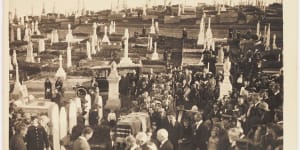
Mourners accompanying the coffin of Henry Lawson at Waverley Cemetery in 1922.Supplied
And with his friend,fellow poet/balladeer and arch-rival,Andrew “Banjo” Paterson who died two decades later in much happier circumstances. Plus his legendary demise into drunkenness,destitution,prison and self-pity.
However,little attention has been paid to the women in Lawson’s life who helped shape his illustrious but tragic career. “There were many women in Lawson’s life,” says Julie Sommerfeldt,manager of the University of Sydney’s library’s Rare Books and Special Collections. “Among them his mother Louisa;his sister Gertrude;his fiancée Mary Gilmore who,like Lawson appeared on a $10 note;Bertha Bredt junior – the wife who divorced him;and his longtime landlady and friend,Mrs Isobella Byers.”
consists of 237 works,Sommerfeldt explains. They include first editions,draft manuscripts,scrapbooks filled with photos,letters,sketches,receipts and IOUs.
They were collected by an astute businessman Harry Chaplin who recognised the worth of the generation of the key figures in the emerging Australian literary canon. “Our collection really builds up a picture of the kind of man Lawson was,” Sommerfeldt says. “Only tantalising glimpses have appeared in public. But the unpublished,ephemeral parts … form an ambiguous and messy portrait of Lawson … full of humour and sly wit,bluster,frustration,charm and despair.
“The women in his poems and short stories[are] either angels or devils.”
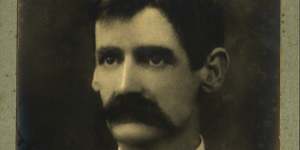
Henry Lawson,a man “full of humour and sly wit,bluster,frustration,charm and despair”.The Henry Lawson collection,University of Sydney
The first woman in Lawson’s life was obviously his mother,Louisa. The second of 12 children born to a station hand and a seamstress in Mudgee,Louisa Albury became not only a poet in her own right but a newspaper proprietor. By the time Henry was born in 1867,her teetotal husband had anglicised his Norwegian name from Neils Larsen to Peter Lawson.
According to theAustralian Dictionary of Biography,when Louisa moved her five children to Sydney in 1883,the marriage was over with the absent gold-mining Peter rarely sending any money to support the brood. Yet,in Sydney,as a single mother she continued to keep the pretence for the sake of her children that Peter was just temporarily absent.
Louisa became a founding member of the Australian suffrage movement,and a staunch supporter of her increasingly drunkard son. What is little known is that Lawson was profoundly deaf for most of his life,having been hospitalised as a child in Mudgee. How much that affected his legendary shyness and his penchant for being permanently pissed we’ll never know.
There’s much dispute whether Lawson was ever engaged to the future Dame Mary Gilmore,though she insisted as late as 1923 (after he died) that there had been a proposal in 1890.
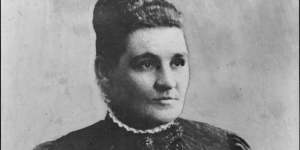
Louisa Lawson,Henry’s mother,early campaigner for woman’s rights,and the first woman in his life.Fairfax Media
Arguably,the most important woman in Lawson’s life was fictional – a short story published inThe Bulletin in 1992 after he’d been dispatched by Archibald to reap some stories from the country known as “back of Bourke”. The story was titledThe Drover’s Wife. It never dignified the wife with a name,but it made Lawson’s. And it has been the subject of an acclaimed recent movie written,directed and starring Indigenous actress Leah Purcell. “Leah,very cleverly,teased out unrealised elements of the story and fleshed it out into a stunning revisionist Western,” says Dr Meg Brayshaw,the university’s John Rowe Lecturer in Australian Literature. “She takes two of the Aboriginal characters and turns them into major characters,revealing the gender and racialised violence that was part of the colonial myth but never talked about.” Purcell also reversed Lawson’s take on the bush. “In the Lawson story,the bush is a constant threat with its snakes,wild bullocks,floods and fires. “In Leah’s film,the bush becomes a place of solace and refuge. It’s the modern world which holds the horrors,” Brayshaw continues.
As for the rivalry with Paterson,Brayshaw says:“Today we conflate them because they were both Sydney-based writers who wrote forThe Bulletin about the bush. But they were very different.
“Lawson was particularly skilled in the short story in a way Paterson never was. Paterson was romantic in his envisagings,while Lawson was more gritty in his depictions of how hard life was in the bush.”
It was through his mother that in 1895 he met his wife,Bertha Bredt Junior – daughter of radical feminist Bertha Bredt. The younger Bertha had been warned Lawson was on a path to alcoholic self-destruction,but married him anyway in April 1896. To tear Lawson away from his bacchanalian Sydney circle,Bertha persuaded him to move first to Western Australia and then New Zealand where Bertha bore their first child,Joseph in 1898.
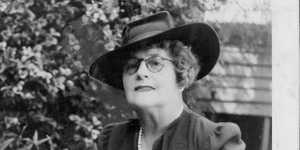
Bertha Lawson,Henry’s wife. was warned against marrying him but married him anyway.Supplied
But they were back in Sydney when daughter Bertha was born in 1900 – and the marriage was on the rocks because Lawson couldn’t resist the grog,kept missing deadlines and had to rely on his meagre earnings fromThe Bulletin to feed his family.
Understandably,Bertha was granted a divorce in 1903 with a damning court indictment:“My husband has during three years and upwards been a habitual drunkard and habitually been guilty of cruelty towards me.“
The final woman in Lawson’s life was his landlady,Mrs Isabella Byers. In the university library are papers by Harry Chaplin,which describe Lawson’s life after the divorce from Bertha. Until the end of 1909,Chaplin wrote,Lawson was constantly “in the courts principally through neglect to provide maintenance for his children. “During these years Henry spent … about 159 days in prison … Every time he got himself into trouble,it was the task of Mrs Byers to rattle round and gather the money to secure his release.“
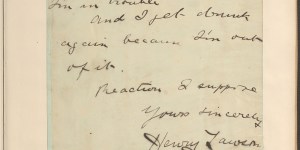
Henry Lawson’s letter to Lala Fisher.The Henry Lawson collection,University of Sydney
Much of the rest of Lawson’s life was spent either in mental homes or as an alcoholic vagabond,sometimes seem with his hat held out at Circular Quay. Seemingly,Mrs Byers never gave up on him. A handwritten account by poet and novelist Zora Cross explains being introduced to Lawson as a young woman and being told “to speak up … he’s deaf”. Lawson just held her hand,saying nothing until “a compact little woman of 40 or so,very neatly dressed in white,gloved and wearing a darkish hat” walked in and was able to initiate conversation with the writer without raising her voice.
“‘The articulate voice of Australia?’” Cross wrote. “He was as cryptic as an Egyptian priest.”
His mother Louisa almost outlived her famous son. Henry died the following year,1922,of a cerebral haemorrhage,aged 55. One of the saddest – but most honest letters in the university library’s collection was written by Lawson himself in 1911 to a patron,Mrs Lala Fisher,a prominent figure in the Sydney theatre and literary worlds back then.“Dear Mrs Fisher,” he wrote. “I get drunk because I’m in trouble and I get drunk again because I’m out of it. Reaction I suppose. Yours sincerely,Henry Lawson.”
Events marking the centenary of Lawson’s death this week include:A Life in Words&Music,narrated by Richard Roxburgh with music by John Schumann,Australian Symphony Orchestra,Festival Theatre,Adelaide,Sept 2;Mudgee library,daily readings,talks and a Friday tour of significant Lawson sites,August 29 -Sept 2,